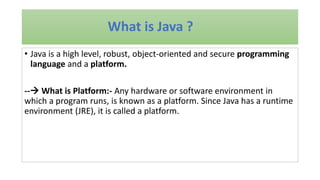

#WHAT IS JAVA CODE#
Features like lambda expressions and the overhaul of the core Collections code will change forever the way that most Java developers write code. Java 8 has added the most radical changes seen in the language for almost a decade (some would say since the birth of Java). This does mean that some of Java’s original design choices, which were expedient in the late 1990s, are still affecting the language today-see Chapters 2 and 3 for more details. The language has undergone gradual revision (but no complete rewrites) since its inception in 1996. These properties are a conscious attempt to serve the goal of protecting the investment that businesses have made in Java technology. Overall, Java is intended to provide a stable, solid base for companies to develop business-critical applications.Īs a programming language, it has a relatively conservative design and a slow rate of change. It builds on industry experience with languages like C++ and tries to remove complex features as well as preserving “what works” from previous programming languages. Java is intended to be easy to learn and to teach.

It is considered to be relatively easy to read and write (if occasionally a bit verbose). This is a human-readable programming language, which is class based and object oriented. Java programs are written as source code in the Java language. We will have more to say about standardization later, so let’s move on to discuss the Java language and JVM as separate, but related concepts. In this book, we’ll only cover Java SE, version 8. Java actually comprises several different, but related environments and specifications-Java Mobile Edition (Java ME), Java Standard Edition (Java SE), and Java Enterprise Edition (Java EE). There is also an open source version of Java, called OpenJDK, which many of these companies collaborate on. Other corporations, such as Red Hat, IBM, Hewlett-Packard, SAP, Apple, and Fujitsu are also heavily involved in producing implementations of standardized Java technologies. The current steward of Java is Oracle Corporation (who acquired Sun Microsystems, the originator of Java). These standards give the developer and consumer confidence that the technology will be compatible with other components, even if they come from a different technology vendor. This means there are specifications for the technologies that comprise the environment. One of the main reasons for the success of Java is that this ecosystem is a standardized environment. Throughout Java’s history, these vendors both cooperated and competed on aspects of Java technology. NET platform and Java is that Java was always conceived as a relatively open ecosystem of multiple vendors. One important difference between Microsoft’s. NET environment, announced a few years after Java, adopted a very similar approach to platform architecture.
#WHAT IS JAVA SOFTWARE#
It comprises the Java language, and the supporting runtime, otherwise known as the Java Virtual Machine (JVM).Īt the time that Java was initially developed, this split was considered novel, but recent trends in software development have made it more commonplace. The Java programming environment has been around since the late 1990s. We’ll briefly cover the history of the Java language and virtual machine, before moving on to discuss the lifecycle of a Java program and clear up some common questions about the differences between Java and other environments.Īt the end of the chapter, we’ll introduce Java security, and discuss some of the aspects of Java which relate to secure coding. In this chapter, we’ll set the scene by describing the Java language (which programmers write their applications in), the Java Virtual Machine (which executes those applications), and the Java ecosystem (which provides a lot of the value of the programming environment to development teams). It is one of the most widely used programming languages in the world, and has been exceptionally successful in business and enterprise computing. Java is a powerful, general-purpose programming environment. Whatever road you may have traveled to get here: welcome.

You may be coming to this ecosystem from another language, or maybe this is your first programming language.


 0 kommentar(er)
0 kommentar(er)
